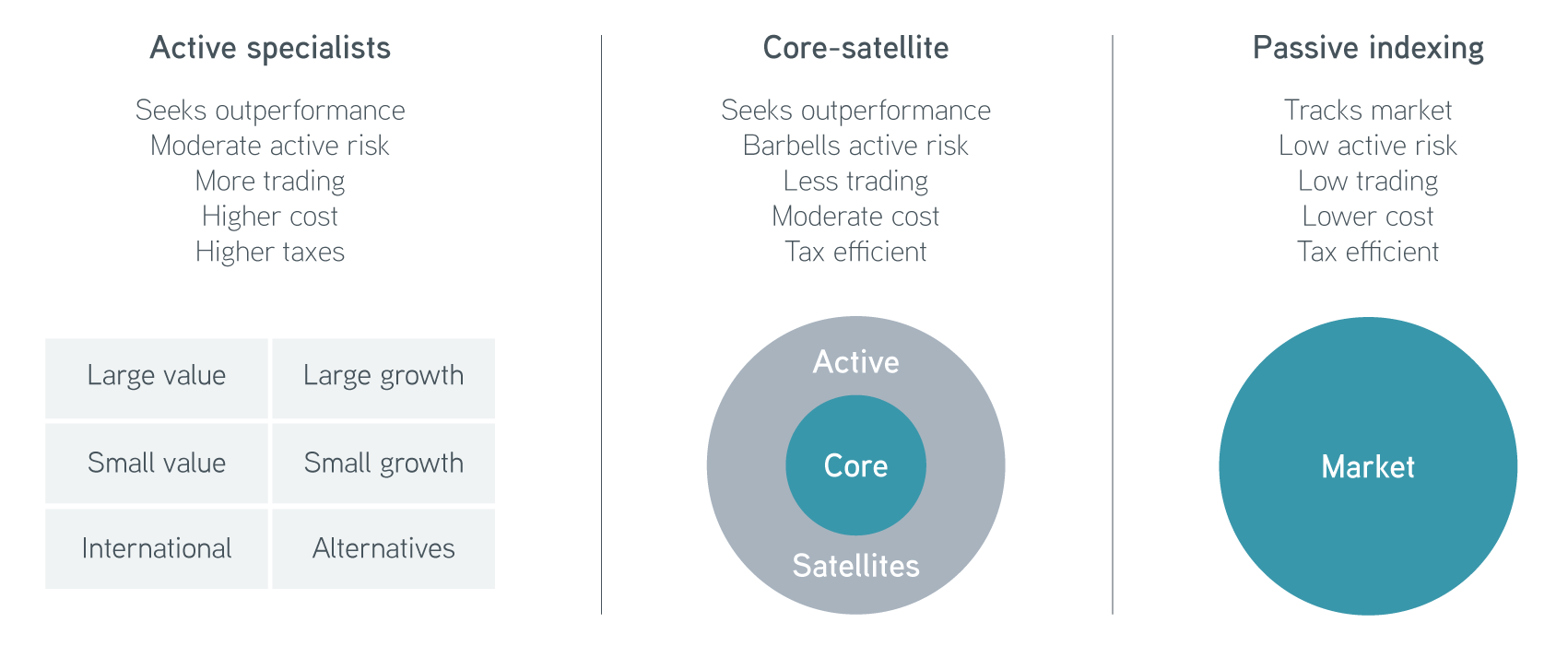Active management can lead to high portfolio turnover and a higher tax bill. Wealth managers might feel that an active strategy could be too inefficient for clients who are sensitive to taxes. Find out how implementing a core-satellite portfolio with a direct indexing core may improve tax efficiency.
Rather than forgoing active management completely, a manager could consider building a taxable investor’s portfolio with a passive core surrounded by more active satellites. Compared with an all-active portfolio, the core-satellite structure can be quite tax efficient. It also tends to be less expensive in terms of management fees, as most of its assets remain in lower-fee passive mandates.
How does core-satellite investing work?
With a core-satellite approach, the manager invests the portfolio’s core in a passive index-tracking mandate, while high-conviction active managers oversee a number of smaller satellite portfolios.
- The core component typically features strategic, long-term allocations that rarely change, such as US large cap equities and tax-exempt fixed income.
- The satellite component may include tactical, shorter-term allocations to active investment strategies, possibly featuring concentrated portfolios and more significant levels of active risk than the core strategies.

For illustrative purposes only.
A core-satellite approach involves lower tracking error risk versus a benchmark index than a fully active portfolio. With a passive core, investors can allocate more of their active risk budget to less benchmark-sensitive mandates in their satellites. From small cap, international or thematic investments to private business or real estate holdings, alternative instruments like commodities or derivatives—even esoteric asset classes like collectibles, art or wine—the satellites offer flexibility to express their investing preferences.
Consider the benefits of active tax management
Where does direct indexing fit into a core-satellite portfolio?
If the manager uses direct indexing for the core, the tax efficiency of a core-satellite structure may be further improved. In such a strategy, the investor enjoys direct ownership of the individual stocks that make up their preferred index. And the manager can opportunistically harvest losses and defer gains, subject to a modest tracking error budget.
Because the portfolio is held in a separately managed account (SMA), not a commingled vehicle, the investor can use the losses harvested under this mandate to offset the taxable gains that the satellite managers generate. In this way, the core-satellite structure offers the potential to increase after-tax returns across the whole portfolio.
What are the benefits to advisors?
With an all-active portfolio, the advisor is responsible for conducting ongoing due diligence on each manager. By allocating the core to more static long-term allocations, the advisor can focus their efforts on the satellite managers with the greatest potential for outperformance. That gives them more time to manage wealth holistically through retirement planning, estate management and charitable giving—strengthening their existing client relationships and creating openings for new ones.
There’s another possible risk-management benefit to consider. Our research has found that a core-satellite approach has resulted in portfolios with better downside capture in after-tax returns.1 So even if the active satellites underperform significantly, tax-loss harvesting in the core can help to soften the drag on an after-tax basis.
The bottom line
Investors who favor active management may still be concerned about the tax inefficiency of an all-active portfolio. Implementing a core-satellite approach with a systematic, rules-based direct indexing core could help solve this problem—promoting deeper conversations with investors about their goals and preferences, while potentially lowering tax bills over the long term.
With 32 years of experience in the customized investment space, Parametric is well equipped to help advisors use direct indexing to strengthen their client relationships.
1 The Journal of Beta Investment Strategies, “Using a Direct Index in a Core–Satellite Portfolio” by Paul Bouchey, Steve Edwards, Spencer Cavallo, 27 July 2023.
Parametric and Morgan Stanley do not provide legal, tax or accounting advice or services. Clients should consult with their own tax or legal advisor prior to entering into any transaction or strategy.
The views expressed in these posts are those of the authors and are current only through the date stated. These views are subject to change at any time based upon market or other conditions, and Parametric and its affiliates disclaim any responsibility to update such views. These views may not be relied upon as investment advice and, because investment decisions for Parametric are based on many factors, may not be relied upon as an indication of trading intent on behalf of any Parametric strategy. The discussion herein is general in nature and is provided for informational purposes only. There is no guarantee as to its accuracy or completeness. Past performance is no guarantee of future results. All investments are subject to the risk of loss. Prospective investors should consult with a tax or legal advisor before making any investment decision. Please refer to the Disclosure page on our website for important information about investments and risks.
8.30.2025 | RO 3780332








